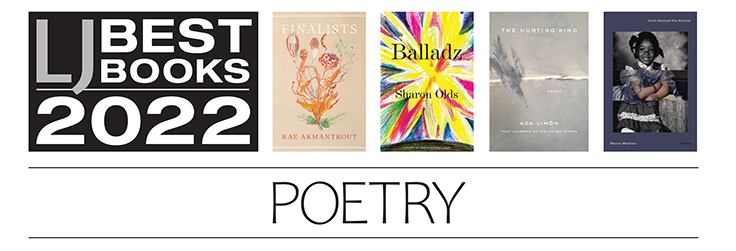Best Poetry of 2022
The best poetry of 2022 captures the moment—and “the ragged white moth of history.”

Download a PDF of this list for posting and sharing
 Armantrout, Rae. Finalists. Wesleyan Univ. ISBN 9780819580672.
Armantrout, Rae. Finalists. Wesleyan Univ. ISBN 9780819580672.
In her masterly new volume, Armantrout takes a deep dive into our constant negotiation with the world, proclaiming “I/ have a great respect/ for the recalcitrance/ of objects.” In the end, what look like aphoristic, cut-crystal fragments of verse are actually reverberant with connection: “By pulsing,/ bars of music// make as if to reconsider.” Armantrout at her most thoughtful.

Bennett, Joshua. The Study of Human Life. Penguin Books. ISBN 9780143136828.
Bennett excited poetry lovers everywhere when he first emerged, and he does even better with this third collection, meditating on new fatherhood, his own childhood, and the burdens of racism as he constructs alternate histories, with Malcolm X and a young Black man shot by the police resurrected. A superbly crafted work written with great intimacy while acknowledging “all the pain we never knew we never knew.”

Hillman, Brenda. In a Few Minutes Before Later. Wesleyan Univ. ISBN 9780819500151.
Hillman’s latest collection gathers meditations on time, nature, contemporary life, social justice, and “the ragged white moth of history” in one gorgeous stampede. These are all big poems, fully observed and richly packed with Hillman’s customary linguistic brio and visceral toughness. A “going-on regardless” that tackles our biggest concerns without lecturing while limning our desire to snag the ineffable.

Limón, Ada. The Hurting Kind. Milkweed. ISBN 9781639550494.
U.S. Poet Laureate Limón’s accomplished new collection is divided into four sections by season. But though she closely and caringly observes the flora and fauna around her, Limón is not offering a naturefest. Instead, she shows how we are enfolded in the world, how we move through not just the seasons but the years. In the end, readers will find themselves “staring into an original joy.”

McCrae, Shane. Cain Named the Animal: Poems. Farrar. ISBN 9780374602857.
As the title suggests, McCrae’s new collection rings biblical in its questions of life and death, beginning and end, the self shattered and the self healing (if never entirely healed). Yet there’s intimacy within the grandeur, as scenes from daily life are writ large with meaning and pathos, and in the end McCrae creates his own cosmology: “I live in which I dream.”

Nurkse, D. A Country of Strangers: New and Selected Poems. Knopf. ISBN 9780593321409.
Selecting from 11 previous collections prefaced by many fine new poems, Nurske muses knowingly on life and loss, offering intimate, intelligent work with a strong sense of place. The new poems reflect strikingly on loosening bonds and life’s diminishing returns in melancholy-mellow verse but remain alert to the world: “Tonight my children are facing live ammunition./ One holds a rock, one brought a Bible, one hides a phone.”

Olds, Sharon. Balladz. Knopf. ISBN 9780525656951.
Ranging from family to mortality to social justice, Olds continues her laserlike attentiveness to the life around her life as she crisscrosses childhood, young adulthood, and contemporary times, including quarantine. The “I” at the center of this rich collection is brave and blazing, the embrace of the world absolute: “Love is the love of who we are, it is a form of knowing.”

Troupe, Quincy. Duende: Poems, 1966–Now. Seven Stories. ISBN 9781644210451.
A poet, biographer of friend Miles Davis, and spokenword performer Troupe here spans six decades while offering fresh, new work. Ranging from “Ghost Voices” to Tiger Woods, he looks at the past while illuminating the present in propulsive work inflected with pain and beauty: “wind/ whipped rag blue squared off with stars/ that are silver bullets/ & pin-striped with bones of mythologized peppermint/ will not hide the corpselynched history.”

Xie, Jenny. The Rupture Tense: Poems. Graywolf. ISBN 9781644452011.
In stunningly evocative verse, Xie uses the photography of Li Zhensheng—“a government-backed photojournalist …[who] made his own theater in cellulose nitrate”—to examine the awful excesses of the Chinese Cultural Revolution and the arduous process of absorbing memory. The 30,000 unapproved negatives Li hid for decades occasion a fierce plunge into the very act of taking pictures and the ultimate unknowability of what is past.
ALREADY A SUBSCRIBER? LOG IN
We are currently offering this content for free. Sign up now to activate your personal profile, where you can save articles for future viewing









Add Comment :-
Comment Policy:
Comment should not be empty !!!